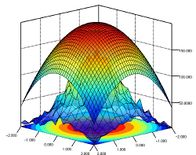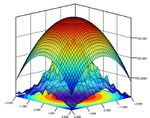DataMelt: Difference between revisions
Jump to navigation
Jump to search
No edit summary |
No edit summary |
||
| (11 intermediate revisions by 2 users not shown) | |||
| Line 1: | Line 1: | ||
{{Data mining and learning analytics tools | {{Data mining and learning analytics tools | ||
|field_logo= | |field_logo=Dm logo125px.png | ||
|field_screenshot= | |field_screenshot=Datamelt 2dhisto.jpeg | ||
|field_name=Computation and Visualization Environment | |field_name=Computation and Visualization Environment | ||
|field_developers=DataMelt community. Led by S.Chekanov | |field_developers=DataMelt community. Led by S.Chekanov | ||
|field_website= | |field_website=https://datamelt.org/ | ||
|field_data_tool_type=Application software | |field_data_tool_type=Application software | ||
|field_license_type=Free&Open source | |field_license_type=Free&Open source | ||
|field_free_software_licence=GPL / GNU for non commercial use. Commercial-friendly license is available | |field_free_software_licence=GPL / GNU for non commercial use. Commercial-friendly license is available | ||
|field_last_release= | |field_last_release=2019/02/02 | ||
|field_last_version=2. | |field_last_version=2.4 | ||
|field_description='''DataMelt is a software environment for numeric calculations, statistics and data analysis ''' | |field_description='''DataMelt is a software environment for numeric calculations, statistics and data analysis ''' | ||
| Line 19: | Line 18: | ||
DMelt creates high-quality vector-graphics images (SVG, EPS, PDF etc.) that can be included in LaTeX and other text-processing systems. | DMelt creates high-quality vector-graphics images (SVG, EPS, PDF etc.) that can be included in LaTeX and other text-processing systems. | ||
The program runs on Windows, Linux, Mac OS. | |||
|field_analysis_orientation=General analysis | |||
|field_data_manipulation_type=Data transformation, Data analysis, Data visualisation | |||
|field_data_transformation_capabilities=Mathematical transformation of data for analysis | |||
|field_analysis_type=Basic statistics and data summarization, Data mining methods and algorithms | |||
|field_visualisation_type=Sequential Graphic, Chart/Diagram, Map | |||
|field_tool_usability=rather easy to use | |||
|field_end_user_type=Students/Learners/Consumers, Teachers/Tutors/Managers, Developers/Designers, Researchers, Organisations/Institutions/Firms | |||
|field_statistics_level=Advanced | |||
|field_programming_level=Basic | |||
|field_system_engineering_level=None | |||
|field_data_mining_models_level=Medium | |||
|field_completion_level=Medium | |||
|field_last_edition=2018/05/23 | |||
}} | |||
== | ==History== | ||
DataMelt has its roots in particle physics where data mining is a primary task. It was created as jHepWork project in 2005 <ref>HEP data analysis using jHepWork and Java, arXiv:0809.0840v2, ANL-HEP-CP-08-53 preprint. CERN preprint, [https://arxiv.org/abs/0809.0840/ arXiv:0809.0840v2] | |||
</ref> using the Java software concept for International linear collider project developed at SLAC. Later versions of jHepWork were modified for general public use (for scientists, engineers, students for educational purpose) since the International Linear Collider project has stalled. In 2013, jHepWork was renamed to SCaVis. In 2015 it became a community-supported project | |||
and was renamed to DataMelt. | |||
DataMelt | DataMelt is hosted by the jWork.ORG portal<ref>jWork.ORG Community Portal focused on Java scientific software. [http://jwork.org/main/].</ref>. | ||
==Documentation== | ==Documentation== | ||
In 2018, DataMelt web page hosted about 600 examples written in Jython, Java, Groovy, JRuby, covering a number of fields, from general mathematics to data mining and data visualization. The Java API documentation includes the description of more than 40,000 Java classes. The DataMelt documentation includes certain restrictions for general public due to the proprietorial nature of the documentation project. | |||
jHepWork was described in the book "Scientific Data analysis using Jython Scripting and Java" | |||
<ref> | |||
Scientific Data analysis using Jython Scripting and Java. Book. By S.V.Chekanov, Springer-Verlag, ISBN 978-1-84996-286-5, [https://www.springer.com/us/book/9781849962865]</ref>. Later it was also discussed in the German Java SPEKTRUM journal | |||
< | |||
</ref> | |||
<ref> | <ref> | ||
DataMelt – Werkbank für technisch-wissenschaftliche Berechnungen und Visualisierungen mit Java und Jython. by Rohe Klaus. Java SPEKTRUM. (in German) volume 5 (2013) 26-28 [https://www.sigs-datacom.de/fachzeitschriften/javaspektrum/archiv/artikelansicht/artikel-titel/integrationsspektrum-scavis-werkbank-fuer-technisch-wissenschaftliche-berechnungen-und-visualis.html] | DataMelt – Werkbank für technisch-wissenschaftliche Berechnungen und Visualisierungen mit Java und Jython. by Rohe Klaus. Java SPEKTRUM. (in German) volume 5 (2013) 26-28 [https://www.sigs-datacom.de/fachzeitschriften/javaspektrum/archiv/artikelansicht/artikel-titel/integrationsspektrum-scavis-werkbank-fuer-technisch-wissenschaftliche-berechnungen-und-visualis.html] | ||
</ref> | </ref>. | ||
More recently, the DataMelt program was described in the book <ref>Numeric Computation and Statistical Data Analysis on the Java Platform (Book). By S.V.Chekanov, Springer, (2016) ISBN 978-3-319-28531-3, 700 pages, [https://www.springer.com/gp/book/9783319285290]</ref>. According to the Springer International, this book was top 25% most downloadable books in 2016 and 2017 in the category "Advanced Information and Knowledge Processing". | |||
<ref> | |||
</ref> | |||
. | |||
Comparisons of DataMelt with other similar packages for statistical and numeric analysis are given in these resources | |||
Comparisons of DataMelt with other | |||
<ref>Comparative Analysis of Information Extraction Techniques for Data Mining, by Amit Verma et al. Indian Journal of Science and Technology, Vol 9, March 2016 [http://www.indjst.org/index.php/indjst/article/download/80464/67992] | <ref>Comparative Analysis of Information Extraction Techniques for Data Mining, by Amit Verma et al. Indian Journal of Science and Technology, Vol 9, March 2016 [http://www.indjst.org/index.php/indjst/article/download/80464/67992] | ||
</ref> | </ref> | ||
| Line 197: | Line 68: | ||
</ref> | </ref> | ||
. | . | ||



